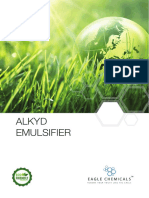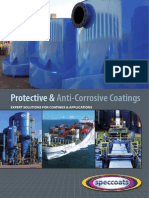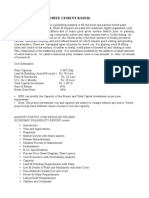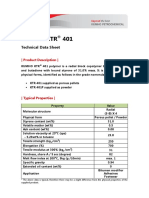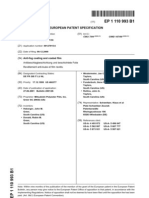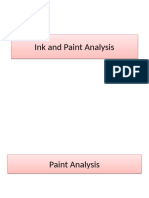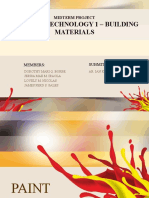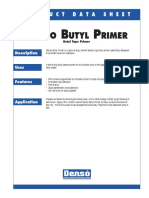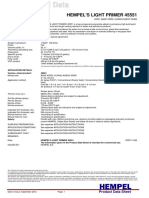0 ratings0% found this document useful (0 votes)
156 viewsCHM441
CHM441
Uploaded by
Shivpoojan SinghThis document discusses the key ingredients and formulation methods used in paint manufacturing, including pigments, solvents, binders, and additives. It provides details on common types of each ingredient used in paints, such as titanium dioxide and zinc oxide as pigments, water and organic solvents as solvents, and alkyd resins and acrylic resins as binders. The document also discusses considerations for formulating paints for different applications like interior house paints, exterior house paints, and paints used for wood substrates.
Copyright:
© All Rights Reserved
Available Formats
Download as PPTX, PDF, TXT or read online from Scribd
CHM441
CHM441
Uploaded by
Shivpoojan Singh0 ratings0% found this document useful (0 votes)
156 views30 pagesThis document discusses the key ingredients and formulation methods used in paint manufacturing, including pigments, solvents, binders, and additives. It provides details on common types of each ingredient used in paints, such as titanium dioxide and zinc oxide as pigments, water and organic solvents as solvents, and alkyd resins and acrylic resins as binders. The document also discusses considerations for formulating paints for different applications like interior house paints, exterior house paints, and paints used for wood substrates.
Original Title
CHM441.pptx
Copyright
© © All Rights Reserved
Available Formats
PPTX, PDF, TXT or read online from Scribd
Share this document
Did you find this document useful?
Is this content inappropriate?
This document discusses the key ingredients and formulation methods used in paint manufacturing, including pigments, solvents, binders, and additives. It provides details on common types of each ingredient used in paints, such as titanium dioxide and zinc oxide as pigments, water and organic solvents as solvents, and alkyd resins and acrylic resins as binders. The document also discusses considerations for formulating paints for different applications like interior house paints, exterior house paints, and paints used for wood substrates.
Copyright:
© All Rights Reserved
Available Formats
Download as PPTX, PDF, TXT or read online from Scribd
Download as pptx, pdf, or txt
0 ratings0% found this document useful (0 votes)
156 views30 pagesCHM441
CHM441
Uploaded by
Shivpoojan SinghThis document discusses the key ingredients and formulation methods used in paint manufacturing, including pigments, solvents, binders, and additives. It provides details on common types of each ingredient used in paints, such as titanium dioxide and zinc oxide as pigments, water and organic solvents as solvents, and alkyd resins and acrylic resins as binders. The document also discusses considerations for formulating paints for different applications like interior house paints, exterior house paints, and paints used for wood substrates.
Copyright:
© All Rights Reserved
Available Formats
Download as PPTX, PDF, TXT or read online from Scribd
Download as pptx, pdf, or txt
You are on page 1of 30
Unit-1.
Formulation and manufacturing methods
for paints and coatings:
Formulation and methods for manufacturing of
paints:
For exterior and interior house design
PAINT TECHNOLOGY
Paint technology is a course in which one studies
about various ingredients used in the making
of paint.
Various ingredients :
pigments, solvents, binders(resins) and additive
s
Pigment
Pigment is a solid substance dispersed throughout the
coating to impart it a color & opacity.
• Pigments may protect the substrate from UV light.
• Pigments change the paint appearance (gloss level) a
nd properties: increase hardness and decrease ductili
ty.
Pigment
• Pigments may be natural, synthetic, inorganic or orga
nic.
• Fillers and extenders are also referred to pigments. Fi
llers and extenders are non-expensive commonly nat
ural inorganic materials added to the paint in order t
o increase its volume, to increase the paint film thick
ness, to impart toughness or abrasion resistance to t
he coating.
Pigment
Various Pigments commonly used:
• Titanium Dioxide (TiO2) is a white synthetic inorganic
pigment existing in two crystalline forms: rutile and a
natase. Titanium dioxide has high refractive index (an
atase 2.52, rutile 2.76).
• Anatase is photochemically active but provides clear
white color therefore its main application is in interio
r paints.
• Photochemically inert rutile is used for protection of
paints from degradation by light. Titanium oxide is th
e most widely used pigment.
Pigment
• Zinc Oxide (ZnO) is a white synthetic inorganic pi
gment having refractive index 2.01.
• Zinc Yellow (Yellow 36) is Zinc Chromate (ZnCrO4)
.
• Yellow Dyes are stable yellow non-toxic organic pi
gments with good opacity
• Benzidine Yellows are yellow-to-red organic pigm
ents for interior applications. They are resistant in
chemicals and stable at elevated temperatures (u
p to 300°F / 150°C).
Pigment
• Chrome Oxide Green is olive-green inorganic pigmen
t with a high level of opacity. Chrome Oxide Green is
the most stable green pigment.
• Phthalocyanine Green imparts green-blue color. It is
used as the pigment for decorative applications. The
pigment is resistant to heat, solvents and alkalis.
• Phthalocyanine Blues are widely spread pigments. T
hey provides a wide spectrum of color from reddish-
blue to yellowish-green. The pigments are non-toxic
and resistant to solvents, chemicals and elevated tem
peratures.
Pigment
• Ultramarine Blue is natural pigment made of t
he semiprecious mineral lapislazuri. The pigm
ent is resistant to fading. It is stable at elevate
d temperatures.
• Vermilion is a natural orangish red pigment co
nsisting of toxic mercuric sulfide (HgS).
• Pigment Brown 6 is red inorganic pigment bas
ed on Iron(III) oxide (Fe2O3).
Pigment
• Red 170 is a synthetic organic pigment widely use
d in automotive industry.
• Dioxazine Violet is organic synthetic pigment.It is
non-toxic and has high tinting strength.
• Carbon Black is the pigment obtained from organ
ic materials (wood, bones) by charring (thermal d
ecomposition in a limited amount of Oxygen). Lar
ge quantities of Carbon Black are used for colorin
g and reinforcing automobile tires.
Pigment
• Iron (II) Oxide (FeO) is inorganic black pigment.
• Examples of fillers and extenders:
• Quartz sand (SiO2). Finely ground quartz is a filler
increasing the abrasion resistance of the paints.
• Talc having the lamellar structure serves as a reinf
orcing phase in the coating. Talc also protects the
substrate from the penetrating water.
Pigment
• Baryte (BaSO4) is a colorless or white inorganic m
ineral having high hardness and chemical resistan
ce. It is used as a reinforcing additive.
• Kaoline Clay is a natural colloid containing finely
dispersed particles of hydrated aluminum silicate.
Kaoline Clay is used in emulsion paints as a gloss r
educing additive.
• Limestone (calcium carbonate, CaCO3) is used in
emulsion paints as a filler extending expensive pig
ments.
Solvent
Solvent (water or organic solvent) is a medium wher
e the binder, pigment and additives are dispersed i
n molecular form (true solutions) or as colloidal disp
ersions, solvent is what causes the paint to be ‘wet’.
Solvents (thinners) are also used for modification of t
he paint viscosity required for the application metho
ds: brush, roller, dip, spray.
Solvent
The solid coating is formed due to evaporation
of solvent therefore the evaporation rate is one o
f the important properties of solvents. Other imp
ortant properties are the ability to dissolve the pa
int ingredients and toxicity.
Various solvents used:
• Water
• White spirits (mineral turpentine spirits). White
spirit is a mixture of is a mixture of saturated alip
hatic and alicyclic hydrocarbons.
Solvent
• Xylene is a pure aromatic solvent having benzene rin
g structure in its molecule (C8H10).
• Toluene is also a pure aromatic solvent with be
nzene ring structure (C6H5CH3).
• Alcohols (n-butanol, isopropanol) are organic c
ompounds having a hydroxyl groups (-OH) boun
d to the carbon atoms of an alkyl group.
• Ketones is an organic solvents, in which carbony
l group (C=O) is bonded to two other carbon ato
ms.
Binder
• Binder is the main ingredient of paints. Binders are p
olymers (resins) forming a continuous film on the sub
strate surface.
Binders are responsible for good adhesion of the coa
ting to the substrate. The binder holds the pigment p
articles distributed throughout the coating. The bind
er is dispersed in a carrier (water or organic solvent e
ither in molecular form (true solutions) or as colloidal
dispersions (emulsions or sols).
Binder
Common binders used:
• Alkyd resins are prepared by the condensation polyme
rization in the reaction of fatty acid and polyols (comm
only glycerol) with polybasic acids.
• Acrylic resins are prepared by polymerization of acrylic
or methacrylic esters.
• Latex (PVA) is a vinyl polymer prepared by free radical
vinyl polymerization of the monomer vinyl acetate.
• Phenolic resins are thermosetting polymers prepared b
y the reaction of simple phenol with aldehydes (eg. for
maldehyde).
Binder
• Urethane resins (polyurethanes) are prepared by
the step-growth polymerization of isocyanates re
acting with monomer molecules containing hydro
xyl (alcohol) groups.
• Epoxy resins is a thermosetting polymer formed
as a result of cross-linking a resin containing short
molecules in the presence of a hardener.
• Chlorinated rubber is prepared through polymeri
zation of the degraded natural rubber (in the pres
ence of atoms of chlorine participating in cross-li
nking.
Additives
Additives are small amounts of substances mo
difying the paint properties.
Various additives used:
• Driers accelerate the paints drying (hardening)
by catalyzing the oxidation of the binder.
• Plasticisers increase the paints flexibility.
• Fungicides, Biocides and Insecticides prevent
growth and attack of fungi, bacteria and insect
s.
Additives
• Flow control agents improve flow properties.
• Defoamers prevent formation of air bubbles e
ntrapped in the coatings.
• Emulsifiers are wetting agents increasing the c
olloidal stability of the paints in liquid state.
• UV stabilizers provide stability of the paints u
nder ultra-violet light.
Additives
• Anti-skinning agents prevent formation of a sk
in in the can.
• Adhesion promoters improve the adhesion of
the coating to the substrate.
• Corrosion inhibitors reduce the corrosion rate
of the substrate.
• Texturizers impart textures to the coatings.
Exterior of the house
The exterior of the any house is generally expos
ed to the temperature changes, different weat
her conditions,moisture contents,direct sunlig
ht,rain water and regular wear and tear.
• Therefore any exterior paint must be tougher
and resist peeling, chipping, and fading from s
unlight.
Exterior of the house
• For these reasons, the resins used in binding e
xterior paints must be softer.
Interior of the house
• Interior paint is made to be scrubbed, resist st
aining, and allow cleaning.
• for interior work oil-based paints are not usual
ly used. The reason is their odor and difficulty
to clean-up.
• For interior paint where temperature is not a
problem, the binding resins are more rigid, wh
ich cuts down on scuffing and smearing
Interior of the house
• For an indoor surface, you may need to clean
and scrub, choose a glossy finish interior paint
, as they resist scrubbing better than flat surfa
ces, which can smear
Paints for wood
• When paint is applied to wood it will fill superf
icial cavities in the rough surface and the medi
um will tend to enter the cell spaces.
• In order to maintain a constant pigment/binde
r ratio in the dry primer film,a proportion of p
olymerized oil or varnish is added to it
• The adhesion of paint film to wood depends o
n good wetting of surface by paint.
Paints for wood
• The durability of a paint system is influenced by t
he ability of the system to accommodate the dim
ensional changes in the wood caused by absorpti
on and loss of moisture.
• Two essential properties adhesion and elasticity a
longwith moisture permeability are important.
• Leadless primers on a number of media including
oleoresinuous varnishes,alkyds and urethane oils
are now manufactured.
Paints for wood
• Non toxic pigments and extenders are employed to giv
e primers suitable for both interior & exterior wood.
• The primers employed are quick drying types applied b
y spray or dip.
• Formulation of general type:
Titanium dioxide 17%
Paris white 11.8%
Red oxide of iron 2.9%
Medium (50% solids) 67.7%
Driers 0.6%
Paints for wood
• Aluminium primers give a superior moisture b
arrier & provide a more suitable surface for th
e adhesion of subsequent coats
• Suitably pigmented acrylic emulsion primers
are non toxic,flexible & adhere well to wood surf
aces.
For hardwoods Al primers based on epoxy esters
or urethane oils are good
Finishing system for wood
Interior
• Conventional alkyd type primer,undercoat & finis
h are commonly used.
• Water-based paints for interiors protect the wood
against scratches and marks, and can be washed
with neutral detergents in an acqueous solution.
• They can be applied to indoor furnishings and oth
er wooden items (chairs, doors, tables, kitchen ca
binet doors, baseboards/skirting boards, etc.).
Finishing system for wood
Exterior
• Acrylic emulsions give excellent performance
• Gloss paints are the most resistant to damage
and the easiest to clean.
• Gloss or semi-gloss paints are ideal for windo
w trim and doorframes, while semi-gloss is a g
ood choice for exterior doors.
• Eggshell finish exterior paint, also often called
satin finish, is well suited to wood.
You might also like
- Colours of War PDFDocument96 pagesColours of War PDFkevin nicklin82% (11)
- Project Report On Red Oxide PrimerDocument7 pagesProject Report On Red Oxide PrimerEIRI Board of Consultants and PublishersNo ratings yet
- Formulation of A Biodegradable and Biosynthetic Latex PaintDocument166 pagesFormulation of A Biodegradable and Biosynthetic Latex PaintRose AdelineNo ratings yet
- Final Shed BOQ PDFDocument5 pagesFinal Shed BOQ PDFShubham Mittal50% (2)
- RedGard Installation InstructionsDocument5 pagesRedGard Installation InstructionsAlex LongNo ratings yet
- Paints Pigments and Industrial CoatingsDocument10 pagesPaints Pigments and Industrial CoatingsRaymond FuentesNo ratings yet
- Group 08 PaintDocument54 pagesGroup 08 PaintHarsh AryaNo ratings yet
- High-Pcv Water-Based Paint Ingredients % by Weight: Ginshicel MH 96-SdDocument3 pagesHigh-Pcv Water-Based Paint Ingredients % by Weight: Ginshicel MH 96-Sdfernando reyes100% (1)
- Paint Ebook MainDocument40 pagesPaint Ebook MainugvickoNo ratings yet
- Glossy FillersDocument6 pagesGlossy Fillerskensley oliveira100% (1)
- Kashyap Enterprises Silicone Polish FormulationDocument2 pagesKashyap Enterprises Silicone Polish FormulationrezaNo ratings yet
- Disperbyk-106 Disperbyk-107 Disperbyk-108: Wetting and Dispersing Additives For Solvent-Borne and Solvent-Free SystemsDocument2 pagesDisperbyk-106 Disperbyk-107 Disperbyk-108: Wetting and Dispersing Additives For Solvent-Borne and Solvent-Free SystemsLê TiếnNo ratings yet
- Solvent Based Polyurethane Thinner Formulation and Production ProcessDocument7 pagesSolvent Based Polyurethane Thinner Formulation and Production ProcessVivekPatilNo ratings yet
- BYK FL-TI1 FloorCoatings enDocument16 pagesBYK FL-TI1 FloorCoatings enKinhNguyen100% (1)
- Alkyd Emulsifier - ES 4045 - 2019 EditionDocument4 pagesAlkyd Emulsifier - ES 4045 - 2019 EditionakbarNo ratings yet
- Speccoats AntiCorrosiveBrochureDocument36 pagesSpeccoats AntiCorrosiveBrochurereinpolyNo ratings yet
- Characterization of Paint Formulated Using SecondaDocument8 pagesCharacterization of Paint Formulated Using SecondasiaNo ratings yet
- Primal™ SF-016 ErDocument8 pagesPrimal™ SF-016 ErAPEX SONNo ratings yet
- Properties of Alkyd ResinsDocument2 pagesProperties of Alkyd ResinsDhivya PrabanjanNo ratings yet
- Alkyd Emulsion Satin PaintDocument2 pagesAlkyd Emulsion Satin Painthardik3578No ratings yet
- 7020P Version 7thDocument1 page7020P Version 7thDuc NguyenNo ratings yet
- Formulation andDocument9 pagesFormulation andAsadoumo AbrahamNo ratings yet
- Duroftal VPE 7186 Coil - e PDFDocument24 pagesDuroftal VPE 7186 Coil - e PDFPratik MehtaNo ratings yet
- Resin Training AlkydDocument41 pagesResin Training AlkydahmadNo ratings yet
- Loa2230e Long-Oil Alkyd Red Iron Oxide Primer Using HALOX® CW-2230Document1 pageLoa2230e Long-Oil Alkyd Red Iron Oxide Primer Using HALOX® CW-2230Muzikant TanerNo ratings yet
- SPC-24 Specialty Glow in The Dark TDSDocument2 pagesSPC-24 Specialty Glow in The Dark TDSnophiaNo ratings yet
- Health and Safety PPE (Personal Protective Equipment's)Document39 pagesHealth and Safety PPE (Personal Protective Equipment's)Pushkraj PotawaleNo ratings yet
- Crown Paints Kenya Limited Supply Chain Value Analysis in Manufacturing FirmsDocument9 pagesCrown Paints Kenya Limited Supply Chain Value Analysis in Manufacturing FirmsAlexander DeckerNo ratings yet
- Paint VarnishesDocument52 pagesPaint Varnishespmanish16No ratings yet
- Talc For Wall Paint - WallpaintDocument9 pagesTalc For Wall Paint - Wallpaintboyo17meiNo ratings yet
- Ink PaintDocument198 pagesInk PaintGovinda GajulaNo ratings yet
- Cryol 912 60 - TDSDocument2 pagesCryol 912 60 - TDSShafiq LatifNo ratings yet
- AIR PRODUCTS Agrochemical Adjuvants GuideDocument8 pagesAIR PRODUCTS Agrochemical Adjuvants GuideRomán M Martín del CNo ratings yet
- Hexion InksDocument16 pagesHexion InksAshish JainNo ratings yet
- AcrylicTexturedPaint PDFDocument2 pagesAcrylicTexturedPaint PDFJude P. DenedoNo ratings yet
- Dry Wall Putty White Cement BasedDocument2 pagesDry Wall Putty White Cement BasedAnurag AgrawalNo ratings yet
- SurfaceDocument26 pagesSurfacejmet2008No ratings yet
- Economic PaintDocument1 pageEconomic PaintForeverNo ratings yet
- Paint ManufacturingDocument2 pagesPaint ManufacturingTamara FernandesNo ratings yet
- Vijay Chemsol: R.S.No.110/5, HM Road, Industrial Area, Sedharapet, Pondicherry-605 111. IndiaDocument16 pagesVijay Chemsol: R.S.No.110/5, HM Road, Industrial Area, Sedharapet, Pondicherry-605 111. IndiaSundara MoorthyNo ratings yet
- Production of Emulsion House Paint Using PolyvinylDocument5 pagesProduction of Emulsion House Paint Using PolyvinylOtegba GiftNo ratings yet
- Kumho KTR 401: ® Technical Data SheetDocument2 pagesKumho KTR 401: ® Technical Data Sheetjulio sierraNo ratings yet
- Antifog 2Document19 pagesAntifog 2Javier BecerraNo ratings yet
- Smooth Masonry PaintDocument1 pageSmooth Masonry Paintvanhung88No ratings yet
- PRIMAL™ AC-2337: Pure Acrylic Emulsion PolymerDocument6 pagesPRIMAL™ AC-2337: Pure Acrylic Emulsion PolymerSameer AhmedNo ratings yet
- Disparlon 174 King IndustriesDocument20 pagesDisparlon 174 King IndustriesvaducNo ratings yet
- ROVACE™ 9900 Vinyl Acrylic Binder: Property Typical ValuesDocument7 pagesROVACE™ 9900 Vinyl Acrylic Binder: Property Typical ValuesNelNo ratings yet
- Primal As-356Document2 pagesPrimal As-356sathitpong.nppcNo ratings yet
- Tinywow - PAINT SIWESS - 10819761Document57 pagesTinywow - PAINT SIWESS - 10819761Precious KayodeNo ratings yet
- Polishes, Coatings and SealersDocument30 pagesPolishes, Coatings and SealersIdkaNo ratings yet
- 81-Strategy Formulation For Decorative Segment of Indian Paint IndustryDocument14 pages81-Strategy Formulation For Decorative Segment of Indian Paint IndustryPrashant SinghNo ratings yet
- Eastman Coatings: Formulating Solutions: Meeting VOC Regulations With CoalescentsDocument4 pagesEastman Coatings: Formulating Solutions: Meeting VOC Regulations With Coalescentsvijay662No ratings yet
- Synthetic Resins Technology HandbookDocument15 pagesSynthetic Resins Technology HandbookniteshacharyaNo ratings yet
- Chapter 3 Traffic Paint: ObjectivesDocument10 pagesChapter 3 Traffic Paint: ObjectivesCloudy DayNo ratings yet
- InternshipDocument60 pagesInternshipSanjay RayNo ratings yet
- A Guide For The Paint Maker 2 EdDocument80 pagesA Guide For The Paint Maker 2 EdMadhu Raj SharmaNo ratings yet
- 20 Different Types of Paints Used For Interior and Exterior SurfacesDocument13 pages20 Different Types of Paints Used For Interior and Exterior SurfacesdavesterdaveNo ratings yet
- What Is Emulsion PaintDocument10 pagesWhat Is Emulsion Paintabdilquadri ishaqNo ratings yet
- Alkox - Concrete ApplicationDocument9 pagesAlkox - Concrete ApplicationWahid KarolNo ratings yet
- Supreme: Premium Opacifying Mineral For Titanium Dioxide ExtensionDocument2 pagesSupreme: Premium Opacifying Mineral For Titanium Dioxide Extensionkensley oliveiraNo ratings yet
- PaintsDocument15 pagesPaintsmhnmndrkNo ratings yet
- Ink and Paint AnalysisDocument36 pagesInk and Paint Analysisgafajap432No ratings yet
- Building Technology 1 - Building Materials: Midterm ProjectDocument68 pagesBuilding Technology 1 - Building Materials: Midterm ProjectAngeLyn CaguimbalNo ratings yet
- TDS 16560 Jotamastic 90 Euk GBDocument7 pagesTDS 16560 Jotamastic 90 Euk GBNgô Trung NghĩaNo ratings yet
- Pds Hempadur 15590 En-GbDocument2 pagesPds Hempadur 15590 En-Gbyasararafat12010No ratings yet
- Technical Specification: 40' X 8' X 8'6" ISO 1AA TYPE Steel Dry Cargo ContainerDocument15 pagesTechnical Specification: 40' X 8' X 8'6" ISO 1AA TYPE Steel Dry Cargo ContainerAnonymous i6ohyRNo ratings yet
- Intertherm 50: Silicone AluminiumDocument4 pagesIntertherm 50: Silicone Aluminiumnoto.sugiartoNo ratings yet
- Barbie Box DIY GuidelinesDocument16 pagesBarbie Box DIY GuidelinesdsignzflyerNo ratings yet
- Vertical Gate Hoisting & Electrificationestimate-09072016Document54 pagesVertical Gate Hoisting & Electrificationestimate-09072016Aditya PatelNo ratings yet
- Bodelac 9000 Matt Alkyd Resin Enamel 07 Mar 2017Document2 pagesBodelac 9000 Matt Alkyd Resin Enamel 07 Mar 2017Mohamed Ahmed100% (1)
- Cased Crossing ProcedureDocument8 pagesCased Crossing ProcedureRehan sheikh0% (1)
- Technical Submittal Sikagard 550 W700SDocument90 pagesTechnical Submittal Sikagard 550 W700SBahaa MohamedNo ratings yet
- TDS CapaPrimeDocument3 pagesTDS CapaPrimeMearg NgusseNo ratings yet
- Saic-H-2029Document12 pagesSaic-H-2029mominNo ratings yet
- Denso Butyl PrimerDocument2 pagesDenso Butyl PrimerALBAMNo ratings yet
- Tream Paper 2.8.editedDocument5 pagesTream Paper 2.8.editedPartho BasakNo ratings yet
- Insucoat WB: ProtectionDocument2 pagesInsucoat WB: ProtectionChidi OkoloNo ratings yet
- Paint Products and Finish ProductsDocument17 pagesPaint Products and Finish ProductsSheree LabeNo ratings yet
- DSR Codes - 1Document108 pagesDSR Codes - 1lakkireddy seshireddyNo ratings yet
- Mastertop 1324Document3 pagesMastertop 1324Doby YuniardiNo ratings yet
- 05 06 Nippon e Marine Ac2022.1esDocument2 pages05 06 Nippon e Marine Ac2022.1esbhz9j4pdwhNo ratings yet
- Roof Water Proofing SystemDocument10 pagesRoof Water Proofing Systemkranthi kumarNo ratings yet
- Protective & Marine Coatings: Zinc Clad Iv EuDocument2 pagesProtective & Marine Coatings: Zinc Clad Iv Eusrinath vNo ratings yet
- Hyperself 1.5 MM - TremcoDocument4 pagesHyperself 1.5 MM - TremcoSenthilkumar NarayananNo ratings yet
- Tar ProductsDocument14 pagesTar ProductsShaival JhaNo ratings yet
- TDS - Tankguard Storage - Issued 04.08.2014Document5 pagesTDS - Tankguard Storage - Issued 04.08.2014Arya Kemal Pratama PutraNo ratings yet
- Quotation: (Co No. PG 0273443P)Document2 pagesQuotation: (Co No. PG 0273443P)Cikgu GayaNo ratings yet
- Deltron® 2000 Basecoat/DBI Interior Basecoat ColorDocument4 pagesDeltron® 2000 Basecoat/DBI Interior Basecoat ColorscottnunesNo ratings yet
- PDS HEMPEL'S LIGHT PRIMER 45551 en-GB PDFDocument1 pagePDS HEMPEL'S LIGHT PRIMER 45551 en-GB PDFRaul JosingNo ratings yet
- PDS - Sika Polysulphide GG - 0914-1 PDFDocument3 pagesPDS - Sika Polysulphide GG - 0914-1 PDFGibbs Per0% (1)














